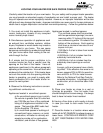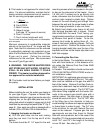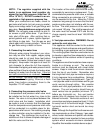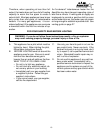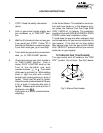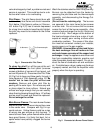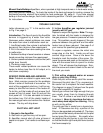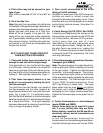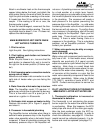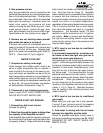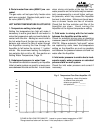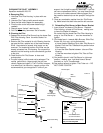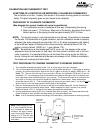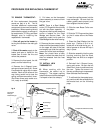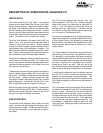
15
4. Pilot orifice may not be correct for your
type of gas.
Pilot orifice is stamped: #15 for LP and #27 for
NG.
5. Air in the Gas Line
Note: Normally this is a problem only at the time
of installation if the pipes have been worked on,a
propane tank has been allowed to empty, or the
heater has been shut down for a long time.
Bleed all the air trapped in the gas line. Be-
cause of the very small pilot orifice (especially
on LP gas models), bleeding out all the air could
take several minutes. Hold the pilot push but-
ton pushed in until all the air has escaped, and
the gas has arrived.
PILOT LIGHTS BUT FLAME GOES OUT
WHEN BUTTON IS RELEASED
1. Pilot push button was not pushed in far
enough or was not held in long enough
Push pilot button in, turn it to the left, then push
it in all the way. Hold it pushed in for at least 20
seconds to give time for the pilot flame to prop-
erly heat the tip of the thermocouple before re-
leasing it.
See Lighting Instructions, Page 11.
2. Pilot flame improperly aimed or is too
weak so it is not properly heating the tip of
the thermocouple
The pilot flame has two flames, one aimed at
the thermocouple and the other aimed at an
angle towards the burners (
see pilot flame dia-
gram, Fig. 4, page 13).
It is extremely impor-
tant that the flame directed on the thermocouple
head be aimed right at it, and that the pilot flame
be a sharp blue flame. If the pilot assembly
has been taken apart for cleaning, the pilot flame
may no longer be properly aimed.
3. Poor circuit connections at the ECOs
(Energy Cut-Off switches)
Oxidation or looseness of the ECO screw con-
nections can result in millivolt current loss
through the thermocouple safety circuit. Clean
terminals with very fine sand paper or an eraser
and re-tighten terminal screws. (See letter V in
Fig 2, page 6).
4. Faulty Energy Cut Off (ECO)- Part 34209
If cleaning and retightening the screws on the
thermocouple wires attached to the ECOs did
not fix the problem, test each ECO by discon-
necting awire from one side of it and
reconnecting it to the other side so both wires
are making good contact. Relight the pilot. If
the pilot flame now remains on, replace the
ECO. If the flame still goes out when the button
is released, the ECO is not defective. Go to the
next step (#5 below).
5. Poor thermocouple connection at the elec-
tromagnet (part #20883)
Note: The electromagnet is located directly be-
hind the pilot push button assembly at the rear
of the gas control. Tighten the thermocouple
connection to the electromagnet. The connec-
tion is a large brass collar and a nut at the back
of the gas valve directly opposite the pilot push
button assembly. The thermocouple end is a
12 mm (15/32") nut which screws into a 16 mm
(5/8") hex fitting on a brass collar. This large
brass collar must be snug before you tighten
the smaller nut in order to avoid twisting and
damaging the thin copper thermocouple tube.
Tighten the thermocouple nut snug but not too
tight.
6. Faulty thermocouple or electromagnet
(parts #23989 and 20883).
Unless these parts are at least 8-10 years
old, it is very unlikely that they are faulty.
Before testing, reconfirm that #2 and #3 are
absolutely correct, and all connections are
clean and tight.
To test the thermocouple, disconnect the
thermocouple from the electromagnet and discon-
nect the thermocouple wires from the two ECOs.



